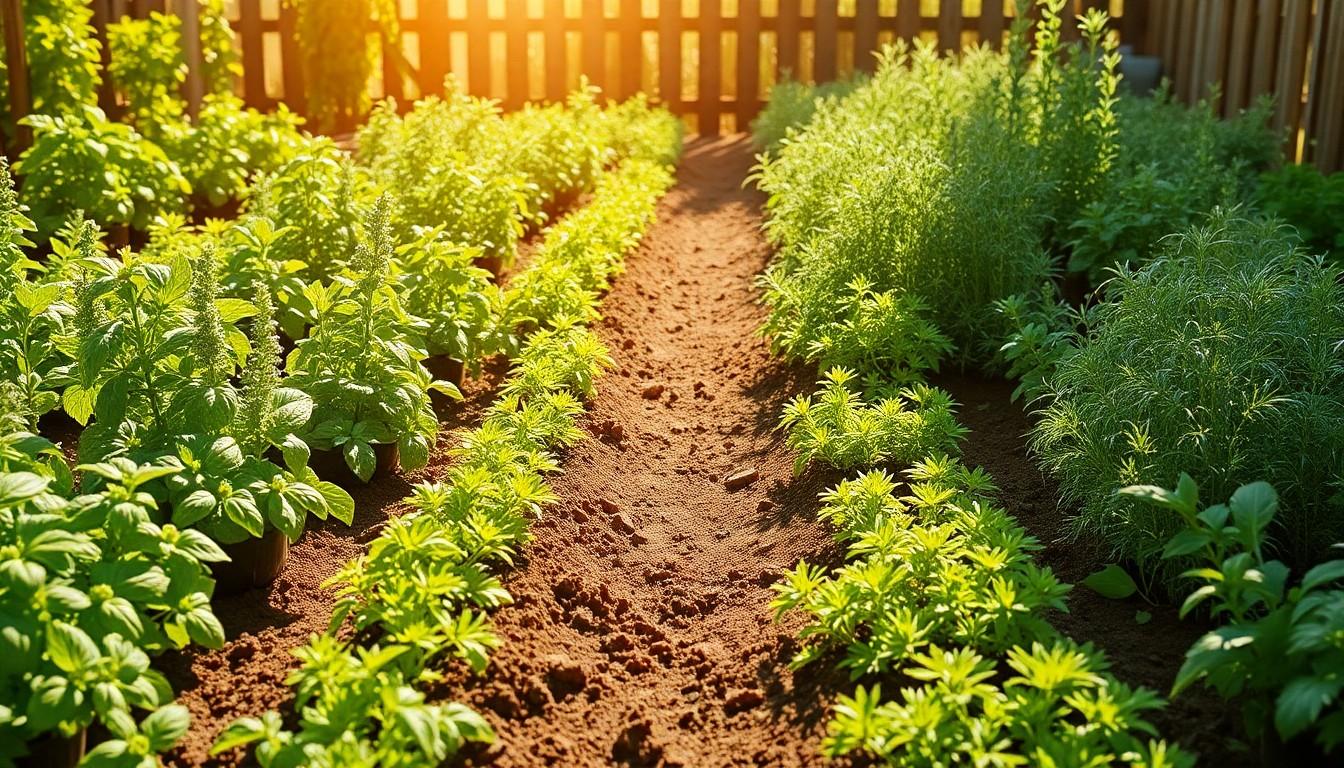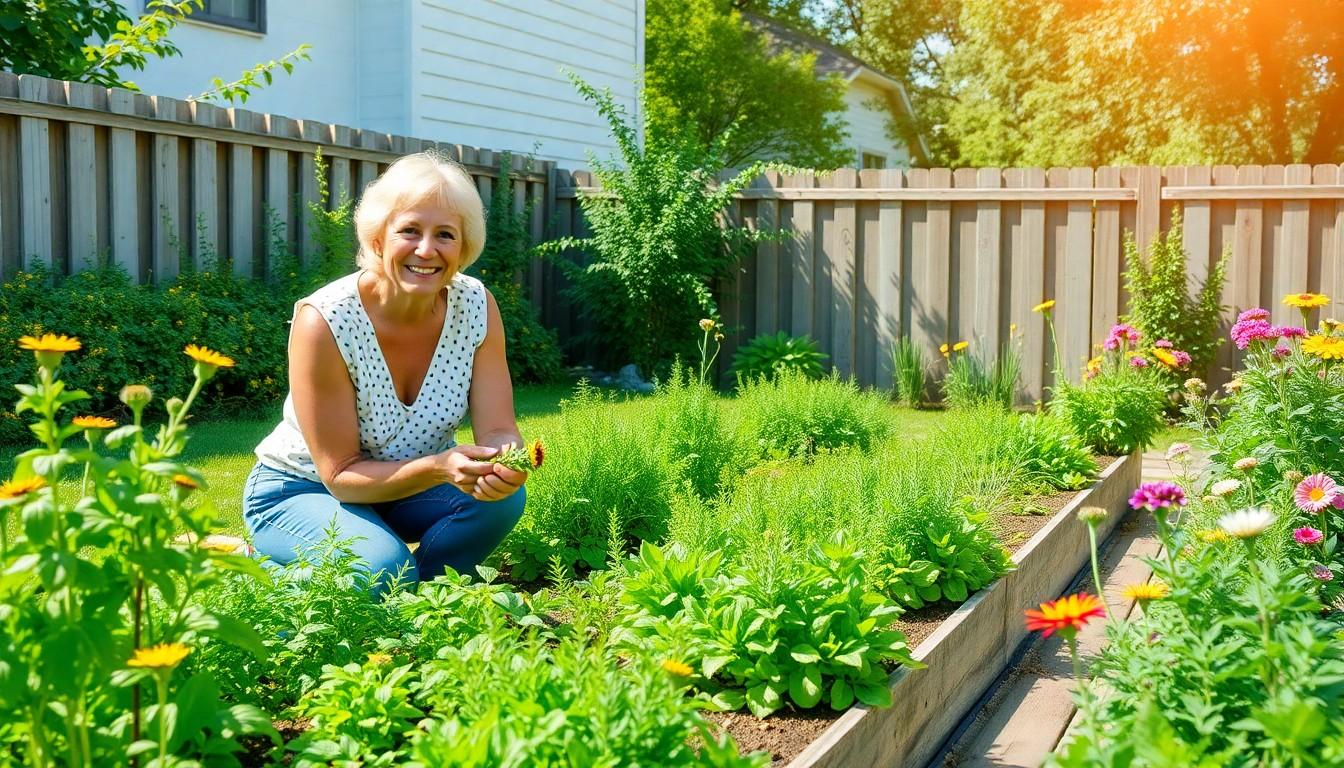Imagine stepping into your backyard and being greeted by a fragrant oasis of fresh herbs, ready to elevate your culinary creations. Herb garden design isn’t just for the green-thumbed elite; it’s for anyone who wants to add a sprinkle of magic to their meals. Whether you’re a novice or a seasoned gardener, creating a space filled with basil, rosemary, and mint can turn your cooking from drab to fab.
Herb Garden Design
Designing an herb garden creates an inviting space that provides both beauty and utility. Various factors influence the layout and selection of plants.
Benefits of an Herb Garden
Fresh herbs elevate culinary experiences. They enhance flavors in dishes and promote healthier eating habits. Gardens provide easy access to aromatic plants like basil, cilantro, and parsley. Growing herbs also reduces grocery expenses, making it economically beneficial. Additionally, herb gardens attract pollinators, fostering biodiversity while offering a vibrant display of greenery.
Essential Considerations for Design
Garden placement significantly affects growth. Select a sunny spot with at least six hours of direct sunlight daily. Soil quality also plays a role; ensure it drains well to prevent root rot. Choosing plants that complement each other enhances the overall aesthetic and function of the garden. Arranging herbs according to height creates visual balance. Incorporating pathways facilitates maintenance and easy access to plants. Finally, consider local climate conditions to select the best herbs for your garden.
Types of Herb Gardens

Herb gardens offer diverse designs to suit varying preferences and spaces. Selecting the right type enhances both aesthetics and function.
Traditional Herb Gardens
Traditional herb gardens feature plots where plants grow directly in the ground. They typically include a range of culinary herbs such as basil, thyme, and parsley. Placing these plants in a sunny area promotes optimal growth. Gardeners often organize them in rows or clusters, creating a classic look. Choosing a designated space allows for easy access, facilitating maintenance like watering and harvesting.
Container Herb Gardens
Container herb gardens provide versatility for any space, including patios and balconies. Using pots or boxes allows users to grow herbs like cilantro, chives, and oregano in limited areas. Ensuring proper drainage is essential, promoting healthy root development. Additionally, relocating containers to follow sunlight patterns caters to each herb’s needs. Combining various sizes adds visual interest, while grouping similar herbs maximizes growing efficiency.
Vertical Herb Gardens
Vertical herb gardens utilize wall space, making them ideal for small areas. Stacking planters or wall-mounted systems enable efficient use of vertical surfaces. Common herbs such as mint, rosemary, and dill thrive in this configuration. This design often incorporates drip irrigation for ease of watering. Incorporating decorative elements can turn these gardens into stunning focal points while providing fresh herbs in compact spaces.
Key Elements of Herb Garden Design
Effective herb garden design incorporates several key elements that ensure both beauty and productivity in the space.
Layout and Spacing
Creating a functional layout maximizes sun exposure and accessibility. Placing taller herbs, like basil, at the back allows shorter plants, such as parsley and chives, to receive adequate sunlight. A distance of 12 to 18 inches between plants promotes air circulation and prevents overcrowding. Square foot gardening can optimize small spaces, using a grid to define areas for various herbs. Grouping herbs according to their water and light needs enhances growth. For easy maintenance, pathways between plant clusters offer convenient access for harvesting and upkeep.
Companion Planting
Companion planting enhances herb garden productivity by fostering beneficial relationships among plants. Certain herbs, like rosemary, repel pests and protect neighboring plants, boosting overall health. Mint pairs well with cabbage, deterring harmful insects from crops. Planting basil alongside tomatoes enhances flavors and promotes growth. Additionally, marigolds attract pollinators, enriching the garden’s ecosystem. Understanding these relationships allows for strategic planting, improving both herb yields and creating a balanced garden environment.
Common Herbs for Your Garden
Herb gardens often feature a variety of essential herbs, enhancing both culinary and medicinal uses. Selecting the right herbs can significantly benefit your gardening experience.
Culinary Herbs
Culinary herbs play a vital role in flavoring dishes and elevating meals. Basil, a favorite in Italian cuisine, pairs well with tomatoes. Thyme adds depth to roasts and stews. Oregano enhances sauces and marinades. Parsley serves as a garnish while providing a fresh taste. Chives offer a subtle onion flavor, perfect for salads and soups. Each of these herbs thrives in sunny conditions, requiring well-drained soil for optimal growth.
Medicinal Herbs
Medicinal herbs provide natural remedies for various ailments. Mint, known for aiding digestion, can be easily grown in containers. Chamomile promotes relaxation and helps with sleep issues. Lavender, with its calming scent, can soothe stress and anxiety. Rosemary supports memory and concentration. These herbs require similar care and thrive in similar environments, allowing for versatile combinations in any garden setup. Each plant contributes not only beauty but also wellness benefits to everyday life.
Tips for Successful Herb Garden Design
Successful herb garden design relies on understanding specific requirements for growth. Focusing on soil and sunlight helps create an ideal environment for herbs.
Soil and Sunlight Requirements
Maintaining well-drained soil is crucial for herb growth. The soil should be rich in organic matter and have a pH level between 6.0 and 7.0. Selecting a location that receives at least six hours of sunlight daily fosters healthy development. Good drainage prevents waterlogging, enabling herbs to thrive without the risk of root rot. Many herbs, including basil and rosemary, flourish in these conditions, while others, like mint, can tolerate partial shade. Regular soil testing ensures the right nutrient balance for optimal growth.
Maintenance and Care
Regular maintenance keeps herbs healthy and productive. Watering should occur when the top inch of soil dries out, ensuring plants receive adequate moisture without becoming waterlogged. Pruning promotes bushier growth while removing dead leaves prevents disease. Incorporating mulch can minimize weeds and retain soil moisture. Fertilizing every four to six weeks enhances growth and flavor. Additionally, monitoring for pests like aphids helps maintain a vibrant herb garden. Engaging in seasonal care tasks strengthens the garden’s resilience and productivity.
Create a flourishing Herb Garden
Creating an herb garden is a rewarding journey that blends creativity with practicality. It offers a unique opportunity to enjoy fresh flavors while enhancing outdoor spaces. By carefully considering layout, plant selection, and maintenance, anyone can cultivate a thriving herb garden tailored to their needs.
Whether choosing a traditional plot, utilizing containers, or exploring vertical designs, the benefits of fresh herbs extend beyond the kitchen. They promote healthier eating, reduce expenses, and contribute to a vibrant ecosystem. Embracing herb garden design not only elevates culinary experiences but also fosters a deeper connection with nature. With the right approach, a flourishing herb garden is within reach for everyone.

